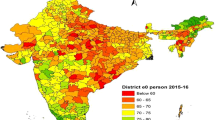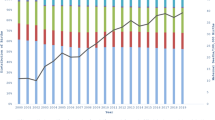Abstract
Objective: In the past two decades, infant mortality rates in the United States declined in African-American and White populations. Despite this, racial disparities in infant mortality rates have increased and rates of low birth weight deliveries have shown little change. In this study, we examine temporal changes in birth weight distributions, birth weight specific neonatal mortality, and the birth weight threshold for an adverse risk of survival within both racial groups in order to explore the mechanisms for the disparities in infant mortality rates. Method: Single live births born to South Carolina resident mothers between 1975 and 1994 and considered White or African-American based on the mother's report of maternal race on the birth certificate were selected for investigation. We define the birth weight threshold for adverse survival odds as the birth weight at which 50% or more of infants in the population died within the first month of life. Results: Despite significant increases in very low birth weight percentages, neonatal mortality rates markedly declined. Birth weight specific neonatal mortality decreased for both races, although greater reductions accrued to White low birth weight infants. By the end of the study period, the birth weight at which over 50% of newborns died within the first month of life was 696 g for Whites and 673 g for African-Americans. Discussion: The ongoing decline in neonatal mortality is mainly due to reductions in birth weight specific neonatal mortality, probably related to high-risk obstetric and neonatal care. Technological developments in these areas may have differentially benefited Whites, resulting in an increasing racial disparity in mortality rates. Moreover, the relatively greater and increasing mortality risk from postmaturity and macrosomia in infants of African-America mothers may further exacerbate the racial gap in infant mortality.
Similar content being viewed by others
REFERENCES
Guyer B, MacDorman MF, Martin JA, Peters KD, Strobino DM. Annual summary of vital statistics—1997. Pediatrics 1998;102(6):1333–49
Carmichael SL, Iyasu S. Changes in the black-white infant mortality gap from 1983 to 1991 in the United States. Am J Prev Med 1998;15(3):220–7
Goldenberg RL, Rouse DJ. Prevention of premature birth. N Engl J Med 1998;339:313–20
Paneth NS. The problem of low birth weight. Future Child 1995;5:19–34
Sepkowitz S. Why infant very low birth weight rates have failed to decline in the United States Vital Statistics. Intl J Epidemiol 1994;23(2):321–26
Paneth NS. Technology at birth. Am J Public Health 1990;80:791–2
Lee KS, Paneth N, Gartner LM, Pearlman MA, Gruss L. Neonatal mortality: An analysis of the recent improvement in the United States. Am J Public Health 1980;70(1):15–21
Hack M, Fanaroff AA. Outcomes of extremely low birth weight infants between 1982 and 1988. N Engl J Med 1989;321:1642–47
Saigal S, Rosenbaum P, Hattersley B, Milner R. Decreased disability rate among 3-year survivors weighing 501–1000 gms at birth and born to residents of a geographically defined region from 1981–1984 compared with 1977–1980. J Pediatr 1989;114:839–46
LaPine TR, Jackson JC, Bennett FC. Outcome of infants weighing less than 800 grams at birth: 15 years experience. Pediatrics 1995;96:479–83
Philip, AGS. Neonatal mortality rate: Is further improvement possible? J Pediatr 1995;126:427–32
The Victorian Infant Collaborative Study Group. Improvement of outcomes for infants of birth weight under 1000 g. Arch Dis Child 1991;66:765–69
Alberman E, Batting B. Trends in prevalence and survival of very low birth weight infants. England and Wales 1983–7. Arch Dis Child 1991;66:1304–8
Lorenz JM, Wooliever DE, Jetton JP, Paneth N. A quantitative review of mortality and development disability in extremely premature newborns. Arch Pediatr Adolesc Med 1998;152:425–35
Tompkins ME, Alexander GR, Jackson KL, Hornung CA, Altekruse JM. The risk of low birth weight: Alternative models of neonatal mortality. Am J Epidemiol 1985;122:1067–79
Alexander GR, Tompkins ME, Altekruse JM, Hornung CA. Racial differences in the relationship of birth weight and gestational age and neonatal mortality. Public Health Rep 1985;100:539–547
Sappenfield WM, Buehler JW, Binkin NJ, Houge CJR, et al. Differences in neonatal and postneonatal mortality by race, birth weight and gestational age. Public Health Rep 1987;102:182–92
Allen MC, Alexander GR, Tompkins ME, Hulsey TC. Racial differences in temporal changes in newborn viability and survival by gestational age. Pediatr Perinat Epidemiol 2000; in press
Kramer MS. Determinants of low birth weight: methodological assessment and meta-analysis. Bull World Health Org 1987;65:663–737
Alexander GR, Himes JH, Kaufman RB, Mor J, Kogan M. A United States national reference for fetal growth. Obstet Gynecol 1996;87:163–8
Allen MC, Donohue PK, Dusman AE. The limit of viability: Neonatal outcomes of infants born at 22 to 25 weeks gestation. N Engl J Med 1993;329:1597–601
Alexander GR, Tompkins ME, Cornely DA. Gestational age reporting and preterm delivery. Public Health Rep 1990;105(3):267–75
Kleinman JC, Kovar MG, Feldman JJ, Young CA. A comparison of 1960 and 1973–4 early neonatal mortality in selected states. Am J Epidemiol 1978;108:454–69
Goldenberg RL. The prevention of low birth weight and its sequela. Prev Med 1994;23:627–31
Horbar JD, Lucey JF. Evaluation of neonatal intensive care technologies. Future of Child 1995;5:139–61
Reger R, Dolfin T, Ben-Nun Y, Herzog L. Survival rate and 2-year outcome in very low birth weight infants. Isr J Med Sci 1995;31:309–13
Schwartz RM, Luby AM, Scanlon JW, Kellog RJ. Effects of surfactant on morbidity, mortality, and resource use in newborn infants weighing 500 to 1500 g. N Engl J Med 1994;330:1476–80
Avery ME, Tooley WH, Keller JB, Hurd SS, Bryan MH, Cotton MF, Fitzhardinge PM, Hansen CB, Hansen TN, et al. Is chronic lung disease in low birth weight infants preventable? A survey of eight centers. Pediatrics 1987;79:26–30
Copper RL, Goldenberg RL, Creasy RK, DuBard MB, Davis RO, Entman SS, Iams JD, Oliver SP. A multicenter study of preterm birth weight and gestational age-specific neonatal mortality. AM J Obstet Gynecol 1993;168:78–84
Howell EM, Vert P. Neonatal intensive care and birth weight-specific perinatal mortality in Michigan and Lorraine. Pediatrics 1993;91:464–70
Schoendorf KC, Kiely JL. Birth weight and age-specific analysis of the 1990 US infant mortality drop. Arch Pediatr Adolesc Med 1997;151:129–34
Hulsey TC, Heins HC, Marshall TA, Martin ML, McGee TW, Meglen MC, Peden SF, Pittard WB, Wells DH. Regionalized perinatal care in South Carolina. J SC Med Assn 1989;85:357–84
Hamvas A, Wise PH, Yang RK, Wampler NS, Noguchi A, Maurer MM, Walentik, CA, Schramm WF, Cole FS. The influence of the wider use of surfactant therapy on neonatal mortality among Blacks and Whites. N Engl J Med 1996;334:1635–40
Phelan ST, Goldenberg R, Alexander GR, Cliver S, Quinney D. Infant mortality and its relationship to the reporting of low birth weight infants. Am J Public Health 1998;88:1236–9
Fichtner RR, Sullivan KM, Zyrkowski CL, Trowbridge FL. Racial/ethnic differences in smoking, other risk factors, and low birth weight among low-income pregnant women, 1978–1988. MMWR CDC Surv Summ 1990;39(3):13–21
Chandra A. Health aspects of pregnancy and childbirth: United States, 1982–88. Vital Health Stat 1995;23:1–74
Hebel JR, Fox NL, Sexton M. Dose-response of birth weight to various measures of maternal smoking during pregnancy. J Clin Epidemiol 1988;41:483–489
Kramer MS. Intrauterine growth and gestational duration determinants. Pediatrics 1987;80:502–11
Alexander GR, Korenbrot C. The role of prenatal care in preventing low birth weight. Future of Children 1995;5:103–20
Piper JM, Ray WA, Griffin MR. Effects of Medicaid eligibility expansion on prenatal care and pregnancy outcome in Tennessee. JAMA 1990;264(17):2219–23
Alexander GR, Hulsey TC, Foley K, Keller E. An assessment of the use and impact of ancillary prenatal care services to Medicaid women in managed care. Maternal Child Health J 1998;1:139–49
Alexander GR, Kogan MD. Ethnic differences in birth outcomes: The search for answers continues. Birth 1998;23:210–3
Shiono PH, Rauh VA, Park M, Lederman SA, Zuskar D. Ethnic differences in birthweight: The role of lifestyle and other factors. Am J Public Health 1997;87(5):787–93
Hulsey TC, Levkoff A, Alexander GR, Tompkins ME. Differences in black and white infant birth weights: The role of maternal demographic factors and medical complications of pregnancy. South Med J 1991;84:443–6
Alexander GR, Baruffi G, Mor JM, Kieffer EC, Hulsey TC. Multi-ethnic variations in the pregnancy outcomes of military dependents. Am J Public Health 1993;83:1721–5
Goldenberg RL, Cliver SP, Mulvihill FX, Hickey CA, Hoffman HJ, Klerman LV, Johnson MJ. Medical, psychosocial and behavioral risk factors do not explain the increased risk of low birth weight among black women. Am J Obstet Gynecol 1996;175:1317–24
Alexander GR. Reducing preterm and low birth weight rates in the United States: Is Psychosocial Assessment the Answer? Maternal Child Health J 1998;2:195–9
Langkamp DL, Foye HR, Roghmann KJ. Does limited access to NICU services account for higher neonatal mortality rates among blacks? Am J Perinatol 1990;7:227–31
Hulsey TC, Alexander GR, Robillard P-Y, Annibale DJ, Keenan A. Hyaline membrane disease: The role of ethnicity and maternal characteristics. Am J Obstet Gynecol 1993;168:572–6
Robillard P-Y, Hulsey TC, Alexander GR, Sergent MP, de Caunes F, Papiernik E. Hyaline membrane disease in black newborns: Does fetal lung maturation occur earlier? Eu J Obstet Gynecol Reprod Biol 1994;55:157–161
Papiernik E, Alexander GR. Discrepancy between gestational age and fetal maturity among ethnic groups. In: Chervenak F, editor. Fetus as a patient Carnforth, UK: Parthenon, 1999:267–273
Kieffer EC, Alexander GR, Kogan MD, Himes JH, Herman WM, Mor JM, Hayashi R. The influence of diabetes during pregnancy on gestational age-specific newborn weight among U.S. black and white infants. Am J Epidemiol 1998;147:1053–61
Alexander GR. Preterm birth: Etiologies, mechanisms and prevention. Prenatal Neonatal Med 1998;3:3–9
Papiernik E, Alexander GR, Paneth N. Racial differences in pregnancy duration and its implications for prenatal care. Medical Hypotheses 1990;33:181–6
Krieger N, Rowley DL, Herman AA, Avery B, Phillips MT. Racism, sexism and social class: Implications for studies of health disease and well-being. Am J Prevent Med 1993;Suppl 9:82–122
Author information
Authors and Affiliations
Corresponding author
Rights and permissions
About this article
Cite this article
Alexander, G.R., Tompkins, M.E., Allen, M.C. et al. Trends and Racial Differences in Birth Weight and Related Survival. Matern Child Health J 3, 71–79 (1999). https://doi.org/10.1023/A:1021849209722
Issue Date:
DOI: https://doi.org/10.1023/A:1021849209722




